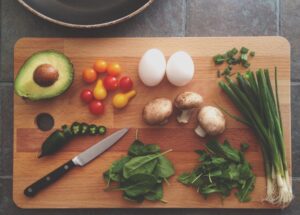Whether you've got plans to redecorate your kitchen or simply want to do a bit of a spring-clean, the '5 zones' method will help you organise the room in a way that makes your life easier. Sorting the room into zones takes the things you use your kitchen for (cooking, cleaning, storing food and tableware) and ensures that everything is in reach when you need it.

The zones are:
- Consumables zone - fridge and food cupboards
- Preparation zone – worktops and/or kitchen island
- Non-consumables zone – cupboards and drawers where you store your cutlery, crockery, cups and glasses
- Cooking zone – oven & hob, kettle and microwave
- Cleaning zone – your sink and/or dishwasher
If you're anything like us, your kitchen probably isn’t set up strictly in these zones. Your microwave might not be right next to your oven, for example, or you might have to take a few steps to put things away after you've washed them up. But chances are you’ve already got clear worktop space next to your hob, ready for food prep, and your fridge and food cupboards are probably all in the same general area. So let's see how you can make sure your kitchen is set up in the most practical way possible...
Consumables zones
Obviously, perishables go in the fridge, but you can organise the rest of your food storage space so that the things you use most are closest to the food prep area. Have your everyday staples on the most reachable shelves. Use the higher shelves in cupboards for ingredients you don't use as often. So make sure things like bread, cereal, pasta and rice, herbs, spices, oils and seasonings are on the lowest shelves. And if baking is an occasional thing, put your icing sugar, cocoa powder, dried fruit and nuts up out of the way.
Preparation zones
You want your food prep zone to be as close to your oven as possible, and ideally to have your kettle and microwave nearby too. Clear the clutter off worktops so you've got room for essentials like a knife block and your most-used cooking utensils, and space to slice, chop and mix. If you can, place things like oil, salt and pepper right next to the hob. That way, when you're cooking pasta, sauces and one-pot dishes like curries and stews, you barely have to move. If you're replacing your kitchen doors, it's a great time to have a look through the cupboards and get rid of anything past its use-by-date.

Non-consumables zone
If you can store your crockery and glassware close to your sink or dishwasher. It makes cleaning up that little bit easier - and hopefully minimises the risk of breakages! Again, have the things you use every day within easy reach, e.g. mugs, cereal bowls, dinner plates. Then put larger, more bulky items like pots and pans in floor units, close to your oven if possible. If you have a warming drawer (the drawer underneath your oven), store baking tins and shallow oven-proof dishes in there.
Cooking zone
Unless you're completely renovating your kitchen, you have to make the most of where things like the oven and sink are placed, and organise your storage space around them. If possible, have your kettle close to your hob - it makes boiling water for pasta, rice and stock much easier. Make sure there's a clear space next to your hob for serving food - you don't want to be carrying hot pans too far.
Cleaning zone
You want your sink and dishwasher (if you have one) close to each other, so that all your washing-up can be relegated to one place. You probably already store your cleaning products under the sink. However, investing in two or three boxes or baskets so you can separate your clothes, sprays and sponges will help you access everything quickly when you need to.
Now you know where everything should go, new cabinet doors make the perfect finishing touches for a refreshed, revamped kitchen. High gloss doors are both stylish and practical - they're a quick update for a tired kitchen and are easy to wipe clean - while white doors add instant brightness and go with literally everything.

